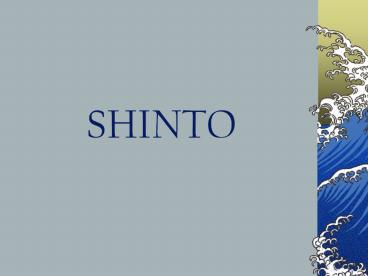SHINTO - PowerPoint PPT Presentation
1 / 17
Title:
SHINTO
Description:
Chinese missionaries brought Buddhism, Confucianism, Taoism ... Shinto dictated ways of daily life, Buddhism dictated thoughts on afterlife. Shinto's Revival ... – PowerPoint PPT presentation
Number of Views:497
Avg rating:3.0/5.0
Title: SHINTO
1
SHINTO
2
What is Shinto?
- The way of the gods
- Ancient, indigenous, mythical, nature religion
of Japan - Wide variety
- Hard to define
- No founder An ethnic religion of the Japanese
people - The root and embodiment of Japanese culture
3
Shintos History
- More than 1500 years old
- Japanese worship had consisted of a variety of
practices - Ancestor worship, animism, many gods
- Chinese missionaries brought Buddhism,
Confucianism, Taoism - Name Shinto originated to differentiate between
the old new customs - Shinto dictated ways of daily life, Buddhism
dictated thoughts on afterlife
4
Shintos Revival
- Shinto was so blended it had almost disappeared
by the 8th century - Tokugawa Regime (1600-1867)
- Military leaders
- Sought to eliminate outside influence
- Religions pushed out (Except Confucianism since
it supported military ethics) - Samurai
- 1853, Commodore Perry opened trade between Japan
and US
5
Shinto Mythology
- Two main texts
- Kojiki (myths of ancient times, origins of gods
and man, islands of Japan) - Nihonji (ancient history of Japan)
- The Kami gods goddesses
- Polytheistic
- Present everywhere, in nature and people
- Creation myth Japan as the center of the world
6
Shinto Mythology
Izanagi (male) izanami (female) (brother
sister) create the islands of Japan
- Amaterasu the Sun Goddess
- Mother of the first emperor of Japan
7
Three kindsof Shinto
- Shrine/Folk Shinto
- State Shinto
- Sect Shinto
8
Shrine Shintoa.k.a. Domestic Shinto
- Jinja (shrines) - Tens of thousands located
throughout Japan - Torii entry gate, separates sacred from profane
space - Household shrines kami-dana (god shelf)
- Contain offerings for ancestors, etc.
9
State Shinto
- Constitution of 1889?end of WWII
- Emphasis on Japanese culture and nationality
(elimination of foreign influences) - Emperors of Japan as divine
- Hierarchy of shrines
- Main shrine at Ise dedicated to Amaterasu
- Mother goddess of Japan
- Palace shrines honoring Amaterasu, other kami,
and emperors - Shrines elsewhere dedicated to national heroes
- 97 of remaining shrines dedicated to local kami
10
Sect Shinto
- 13 recognized sects
- Mountain worship
- Faith healers
- Pure Shinto (similar to yoga practices in
Hinduism) - Some combine Shinto with influences from Buddhism
or other religions
11
The Problem for Humans
- Alienation
- Humans can become ritually unclean and need
purification - Estranged from the kami and need communication
- Alienated from family, ancestors, community,
emperor thru failure to do whats expected - Solution reconciliation thru offerings, prayer,
heroic deeds, ritual suicide
12
Community
- Devotion to family and country governs all
conduct - People are a part of something (family, nation,
etc.) - Duty to sacrifice your selfish impulses to good
of the whole - Groups govern your behavior and consequences
13
The FourAffirmations
- Tradition and Family
- Love of Nature
- Physical cleanliness
- Matsuri festivals that worship and honor the Kami
14
The End
15
Shinto PracticesTradition and Family
- Life cycle celebrations take place at shrines
- Newborns first visit to shrine
- 7-5-3 festival blessings for boys age 5, girls
ages 3 7 - Entry to adulthood (age 20)
- Marriage
- (since Shinto celebrates life in this world, in
death, the Japanese turn to Buddhist rather than
Shinto rituals)
16
Shinto Practices
- Love of Nature
- Annual cycle of seasonal festivals
- Physical Cleanliness
- Misoji - Water purification rites to wash away
impurity, thus restoring original purity
17
Shinto on the Web
- Ancient Japan Shinto Creation Stories
http//www.wsu.edu/dee/ANCJAPAN/CREAT.HTM - Visit a Shinto shrine on-line Tsubaki Grand
Shrine of America http//www.tsubakishrine.com/te
st/home.asp - The Shinto Online Network Association
http//www.jinja.or.jp/english/s-0.html































